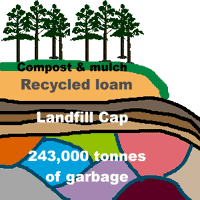Why do we need Calgary’s landfills?
Learn more about Calgary's landfills, including what people throw away, how a landfill works, and what happens when a landfill closes. Find this information and more in the categories listed below:
- How do Calgary's landfills work?
- What happens when a landfill closes?
- Why do we need landfills?
- How is a landfill reclaimed?
- What is Calgary's long-term waste goal?
- How do we protect public health and safety?
How do Calgary's landfills work?
Today's modern landfills are very different than the open dumping grounds of decades before. Our landfills are highly engineered and sophisticated facilities that carefully manage our wastes for minimal impact to the environment.
Before we open a landfill, it requires extensive engineering and planning to include features that are specifically designed to protect the surrounding environment from any potentially adverse affects.
These features include layers of compacted clay, synthetic materials and gravel that "line" the bottom of a landfill to contain the garbage and collect waste liquids (leachate). Layers of garbage are tightly compacted to reduce the volume - both to save space and to reduce the amount of oxygen in the garbage. Each layer is then covered with soil to further contain the garbage.
Finally, when a landfill is closed, it is capped with more layers of soil, similar to the liner, and reclaimed by covering it with topsoil and replanting the surface with natural vegetation. The result is an enclosing or entombment of our garbage, which stores our waste in a controlled and continually monitored landfill structure.
What happens when a landfill closes?
When a landfill closes, we continue to monitor it to see how the garbage is decomposing and how this could impact the surrounding environment. Studies show that the process of decomposition in a landfill is extremely slow. In fact, some wastes such as glass, metals and plastics may not break down at all.
In this type of enclosed environment with little oxygen, the organic wastes found in our garbage produce landfill gas which consists roughly of equal parts carbon dioxide and methane (a greenhouse gas that is 25 times more potent than carbon dioxide) – making our landfills the number one single source of greenhouse gases in Calgary.
As rainwater and liquid wastes percolate through the garbage, they mix to become leachate, a highly concentrated garbage soup which may have adverse affects on the environment. This leachate needs to be continually collected through a system of pipes and removed for treatment.
Why do we need landfills?
As long as we produce garbage, we will need landfills to store it. In the past, landfill spaces had limited reuse possibilities. They could not be used as residential or commercial space due to the unstable nature of garbage as it settles, and the need to monitor leachate and methane production.
Today, we are able to give these spaces a new life. For example, we are proud to be a partner in the Blackfoot Forest - fourth in the BP BirthPlace Forest family. We are excited at the opportunity to reclaim this the closed Blackfoot waste disposal site and turn it into a green space that will once again see public use for all Calgarians.
Through extensive environmental improvements, this landfill has now been retrofitted with modern sanitary features designed to protect the natural environment in the surrounding area. These enhancements will also allow us to continue to monitor and control this closed site while it is enjoyed as a public park.
How is a landfill reclaimed?
Not only has the BP BirthPlace Forest reclaimed the landfill by planting 6,000 new trees, the tree root system will also serve as moisture and erosion control for the whole area. Trees are also important in the reduction of greenhouse gases produced by landfills. Additionally, the forest has benefited from the reuse of many recycled components including the following:
- 30,000 cubic metres of recycled loam were salvaged from various development projects around Calgary.
- 2,000 cubic metres of leaf compost were used from The City's former Leaf and Pumpkin composting program.
- 320 cubic metres of tree mulch were used from The City's annual Christmas Tree Composting program.
Other notable environmental features of this forest include a high efficiency irrigation system powered by solar panels, as well as the planting of native species on the steepest part of the slope.
This is one of the largest greening initiatives in Calgary's history. That's why we've called this our greenest forest ever!

How do you protect public health and safety?
Municipal landfill operation is regulated by the Province, under the jurisdiction of Alberta Environment. The government grants The City an Operating Approval which specifies all of the requirements that must be met to ensure the landfill is operating safely. Under provincial regulations, residential development must be located at least 300 metres from a landfill property boundary.
The City takes its responsibility to protect public health and the environment seriously. A routine monitoring program is conducted year-round to sample groundwater and soil vapour conditions. Monitoring continues even after a landfill is closed.
For active landfills, the City of Calgary works hard to protect citizens. Each of the three City landfills follows safety guidelines to ensure safe landfill use.

